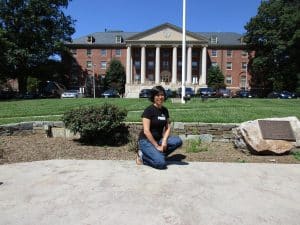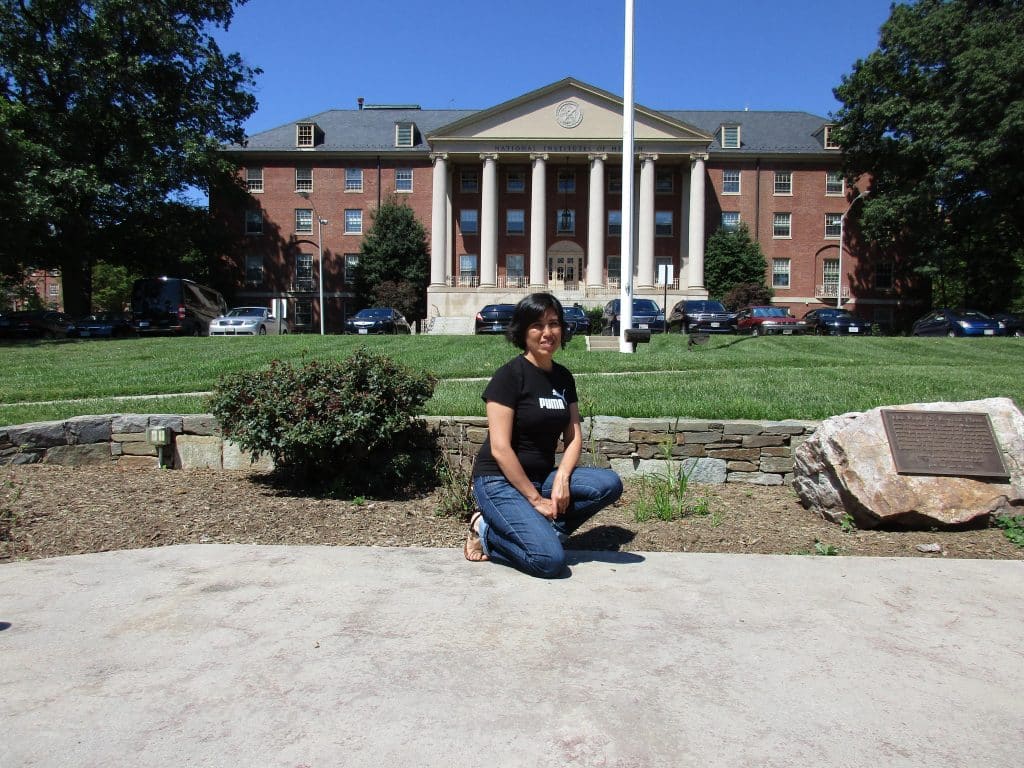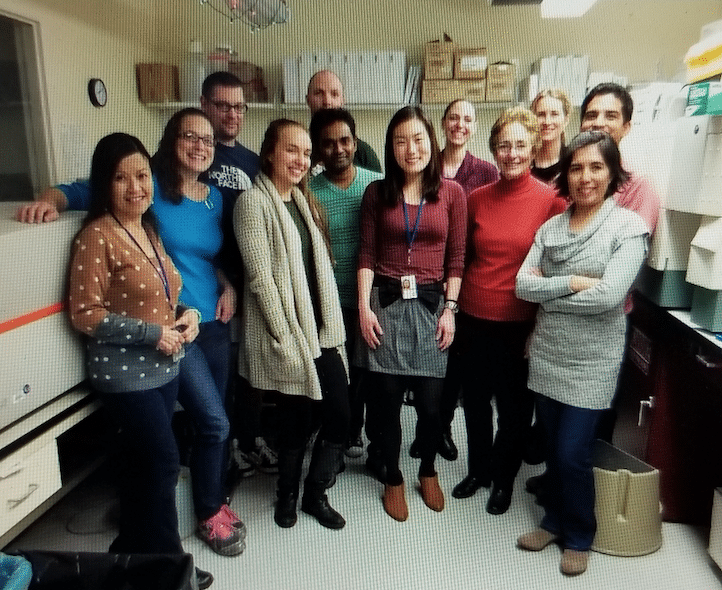An interview with Iskra Tuero
Posted by Mariana De Niz, on 16 May 2023

MiniBio: Dr. Iskra Tuero is a principal investigator at Universidad Peruana Cayetano Heredia, where she leads the laboratory of Immunobiology of Infections since 2017. Iskra studied for her undergraduate degree in Cusco, Peru, at Universidad Nacional de San Antonio Abad. During this time, she found a passion for Biochemistry, which she continued to pursue during her postgraduate career. She studied for her MSc and Ph.D. in Biochemistry at Universidad Peruana Cayetano Heredia. During this time, she entered the field of Immunobiology and Cell Biology. Between 2011 and 2016, Iskra did a postdoc at NIH in Bethesda, Maryland, USA, before returning to Peru as a principal investigator. She recently became a member of the Executive Committee of Latin American Bioimaging (LABI), where she hopes to contribute to the regional efforts to build and strengthen capacities related to imaging, in the region.
What inspired you to become a scientist?
Since I was very young, I was curious. I wondered why plants were green, why roses were red, why people have to eat several times a day, or why people get sick. I applied to Medicine but didn’t get in. The other choice was to study Biology – a discipline that explains life -biological processes that happen in living organisms. I got accepted and took several courses including Ecology, Botanics, Zoology, and Microbial Physiology, among others. One I loved was the course on Microbial Physiology – because I learned that biological processes had a molecular explanation. I understood, for example, the chemical equation that shows how glucose converts into ethanol – a process performed by yeast. In addition to Biology, I discovered my love for Biochemistry.
You have a career-long involvement in biochemistry, immunobiology and microscopy. Can you tell us a bit about what inspired you to choose this path?
During my undergraduate degree, I bought a book on biochemistry and read every page. In later years, I had the subjects of Biochemistry I and II, which strengthen my interest in molecules. I later studied for an MSc in Biochemistry and a Ph.D. also in Biochemistry and Molecular Biology. I’m from Cusco – and I studied for my undergraduate degree at Universidad Nacional de San Antonio Abad in Cusco. For my postgraduate degrees, I moved to Lima and studied at Universidad Peruana Cayetano Heredia. At some point, I had the chance to work in biochemistry applied to infectious diseases, so I switched to Cell Biology and Immunology. Still, cells communicate via molecules, and immune cell responses are based on molecules too. It’s different levels of organization that allow us to understand life. I did a 5-year postdoc at the NIH in Bethesda, Maryland, USA, before coming back to Peru as an independent researcher. That’s where I made the big switch to Immunology. That’s my career path so far! For a lot of my career, I worked with flow cytometry – you utilize fluorochromes to get insights into cells. But cytometry is limited in many ways. I love microscopy because it allows you to visualize and understand life processes beyond just counting. I think microscopy is complementary to other tools in research. Microscopy can be used for many areas beyond Biology, so it’s a powerful tool altogether.

Can you tell us a bit about what you have found uniquely positive about becoming a researcher in Peru, from your education years?
As a student, I always felt that the information you receive in school as a student is limited because there’s a syllabus and a time to stick to. So as a student, you have many doubts at the end of the class- and the motivates you to read more, and find more resources on your own – this promotes independence. This has positive and negative aspects. If you don’t have this initiative to look for answers on your own, you might end up limited in what you know. I think that’s how knowledge is formed in general.
Can you tell us about your day-to-day work as a group leader at Universidad Peruana Cayetano Heredia?
While I was working as a postdoc, I realized that the knowledge and skills I was acquiring could be applied and pursued in my own country. A week ago, we performed an experiment in my lab which I saw once during my postdoc training at NIH in Bethesda. It was successful and exciting. For me, it’s a dream come true to be able to do what I like and to bring back this expertise to Peru. In addition to research, I also teach undergraduate and graduate students. My routine is to supervise students, help them plan their experiments and other administrative issues. It’s a combination of activities really.
Did you have many opportunities to interact with other Latin American groups, outside of Peru?
Yes, definitely. In the institute where I did my postdoc, there were many Latin Americans.

You are a member of the LABI Executive Committee – can you tell us more about your current role and your future hopes in this position?
My introduction to microscopy was somehow serendipitous. I was working on Immunology, and we needed to do microscopy – I had never done it before. So, I contacted members of LABI and attended an event they organized, to learn more about microscopy. That’s where I realized, and was amazed by the great efforts being done by LABI members, to advance microscopy in our region. It’s an incredible endeavor. I’m learning a lot from them, from their dynamics and enthusiasm and growing as a group – and I think a lot can be done in several lines of work. I want to learn more about their strategies for strengthening microscopy in the region. In Peru we are not as united, and it’s something we should work on.
Who are your scientific role models (both Peruvian and foreign)?
I don’t think I have any in particular. I appreciate and have learned from each scientist I met in my career. Also, I’ve always found guidance in what my parents taught me: to have values. Everyone has their own goals, and success is to be able to achieve what one sets one’s mind to.
What is your opinion on gender balance in Peru, given current initiatives in the country to address this important issue? How has this impacted your career?
In Peru, the council called CONCYTEC promotes research. For years, it has provided funding for research and activities promoting participation of women in science. They have done a good job promoting women in research, but not enough. For example, they provide monetary incentives when research includes women investigators in the team. I think it’s important to give visibility to women in science. I’ve never felt discriminated against. I’ve never felt that I couldn’t or shouldn’t do something within my work, simply because I am a woman. I’ve also never felt external limitations. Maybe there have been things, but luckily, I’ve been oblivious to this.
Are there any historical events in Peru that you feel have impacted the research landscape of the country to this day?
Not that I can think of. When I was studying for my undergraduate degree, we didn’t know much about CONCYTEC. When I came back from my postdoc in the USA I realized how helpful CONCYTEC’s presence has been to the country’s scientific development since 2011. I think its creation and evolution has been a main “event”, if we can call it so, for the country’s scientific landscape.
Have you faced any challenges as a foreigner, when you have worked outside Peru?
When I first went to Bethesda, perhaps the language was a challenge. But on a day-to-day basis, because you have to use a foreign language 24 hours a day, you end up thinking in English all the time. I also didn’t know as much about the research topic as the rest of the team. So, it took considerable effort to be on the same page as everyone else because I came from a different field. I think these were the two main challenges I faced. Challenges make you demand and expect more from yourself, in my opinion.

What is your favourite type of microscopy and why?
I love confocal microscopy. After working with flow cytometry and fluorescence microscopy for so long in my career, I think confocality allows you to see various layers in a sample through optical sectioning. This capability permits you to rebuild the tridimensional structures of your interest. So, it is a powerful tool not only in biology, but in my case, immunology.

What is the most extraordinary thing you have seen by microscopy? An eureka moment for you?
I like to see a cell’s organization, for example, the cytoskeleton – I think it made me perceive cells as a house where every organelle is a room with specific functions. I find the cytoskeleton in specific, something fascinating. It allows life to happen within the cell.
What is an important piece of advice you would give to future Peruvian scientists? and especially those specializing as microscopists?
Be curious, and keep in mind that in science, truth is relative. What, today, we know as true can change tomorrow as new technologies become available and paradigms shift. Knowledge is not absolute. Be curious to pursue knowledge beyond the one that is “given” to you freely. That’s how you expand your horizons.
Where do you see the future of science and microscopy heading over the next decade in Peru, and how do you hope to be part of this future?
I hope that support for science might improve in Peru- there is a lot of political instability in the country, and corruption too. I think this has had a negative impact on science. I hope once this government is over, we can have a new leader that realizes that scientific research is essential for the country. We need to support research and innovation in science to generate development and improve life quality. The current local institution supporting science needs to be strengthened. I think I will continue to do science, despite the difficulties and limitations. I think that will be my contribution – to not give up.
Beyond science, what do you think makes Peru a special place to visit?
Peru has a beautiful history. The Inca Empire built a wonderful culture that we preserve with enormous effort and dedication to this day. We also have unique agriculture resulting in unique gastronomy. People are very warm-hearted and affectionate and also very resilient. Despite all the difficulties we have been through in Peru, people are still hopeful and pushing forward.


 (No Ratings Yet)
(No Ratings Yet)
